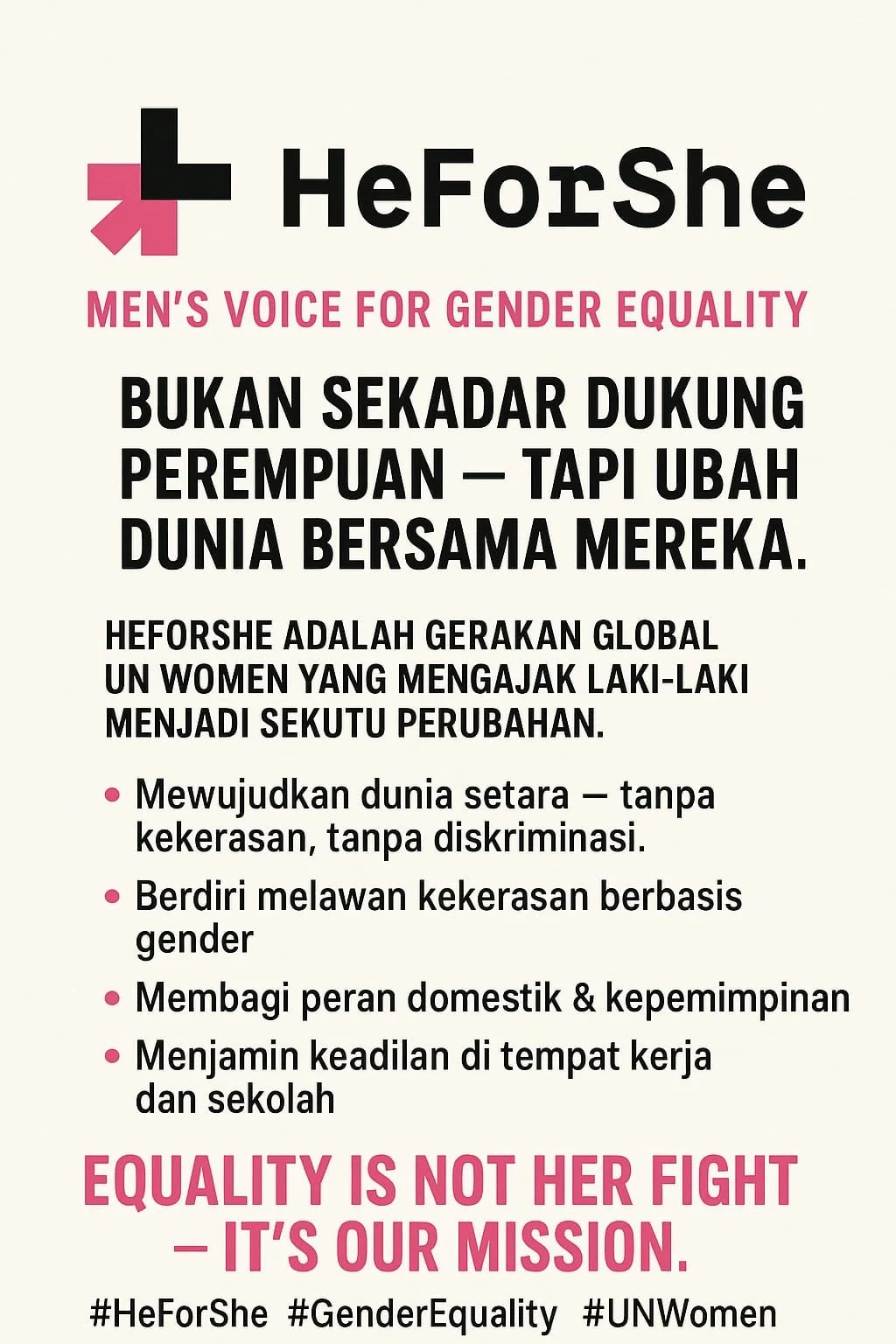HE FOR SHE
#HeforShe #GenderEquality #UNWOMEN
The HeForShe policy is a global initiative launched by UN Women (the United Nations Entity for Gender Equality and the Empowerment of Women) in 2014.
Its goal is to encourage men and boys to play an active role in the fight for gender equality — not just as spectators, but as allies and agents of change.
Main Objective
HeForShe is based on the premise that gender equality is not just a women's issue, but an issue of humanity and social justice.
Its mission is to create a world where men and women enjoy equal rights, opportunities, and dignity.
HeForShe Policy Pillars
This campaign has several policy and action focus areas:
a. Leadership and Participation
Encourage men in leadership positions (political, corporate, community) to create gender-equitable policies.
Eliminate toxic masculinity norms that exclude women from decision-making.
b. Justice and Human Rights
Support legal policies that protect women from gender-based violence.
Ensure men share responsibility for preventing violence, not just reacting.
c. Education and Employment
Promote equal access to education and career opportunities.
Encourage men to be role models in dividing domestic labor and caregiving responsibilities.
d. Health and Safety
Integrate a gender perspective in health policies, including reproductive and mental health.
Encourage men to recognize that gender equality also improves their quality of life.
Global Commitment
More than 2 million men in over 100 countries have signed the HeForShe commitment.
Several countries and large companies (e.g., PwC, Tsinghua University, and the Icelandic government) have even created HeForShe IMPACT Commitments, concrete targets to:
Close the gender pay gap,
Increase women in leadership positions,
Improve job security for women.
HeForShe Policy Principles
1. Inclusive and participatory — involving all genders.
2. Transformational — not just symbolic, but changing social structures.
3. Data-driven action — measuring real progress on equality indicators.
4. Accountability and transparency — every participating institution must report its progress.
Achievements and Real
Efforts in Indonesia
1. UN Women + Srikandi BUMN MoU & WEPs (Women's Empowerment Principles)
In February 2025, UN Women Indonesia and the Srikandi BUMN community signed an MoU to strengthen gender equality in SOEs.
Several SOEs (e.g., ANTAM, BTN, WIKA, InJourney) also signed the WEPs, as a commitment to making business practices and work culture more gender-responsive.
The targets set include: 25% representation of women in SOE leadership.
2. Government Strategy & Policy: Gender Mainstreaming
Indonesia has a Gender Mainstreaming Policy (Presidential Instruction No. 9 of 2000), which is integrated into the Long-Term Development Plan (RPJPN) and the national SDGs Agenda.
Indonesia's commitment in international forums to increase women's participation in decision-making, reduce maternal mortality, and eradicate violence against women and children.
3. Campaign & Public Awareness
HeForShe Run 2018 in Jakarta: Thousands of people supported the gender equality movement through a run held in conjunction with International Women's Day.
Support from regional leaders: Several governors/provinces have expressed their commitment to HeForShe in efforts to create a safer and more equitable environment for women and children.
UN Women and local partners also continue to conduct educational programs, research, and surveys on violence against women, women's digital participation, and campaigns for equality in the workplace.
Remaining
Challenges
1. Representation Gap
Despite progress, the percentage of women in parliament is relatively low (~21.9%) and remains far from parity.
Many leadership positions in the public and private sectors are still not equally represented.
2. Violence and Security
Significant rates of violence against women persist: reporting of physical/sexual violence over a period of time remains high.
Legal protection and its implementation on the ground are not evenly distributed across all regions.
3. Data & Monitoring
Data is limited for several important indicators: for example, the gender pay gap, unpaid work (care/domestic work), and data on remote areas.
Monitoring and evaluation of the implementation of commitments often rely on local initiatives or NGOs, rather than a consistent national system.
4. Social & Cultural Norms
Patriarchy and gender stereotypes remain strong in many communities, influencing traditional gender roles, the division of domestic labor, and women's access to public decision-making.
Resistance to change, especially in conservative societies, and challenges to gender education at the grassroots level.
Brief Conclusion
Indonesia has made concrete positive steps in implementing the HeForShe initiative/gender equality principles: through policies, corporate commitments, public campaigns, and advocacy activities. However, to achieve deeper and more comprehensive goals, more is needed:
Stronger and more sustainable political commitment,
Strengthening regulations and enforcement at all levels of government,
Improved monitoring systems,
Cultural changes and social norms that support equality.




